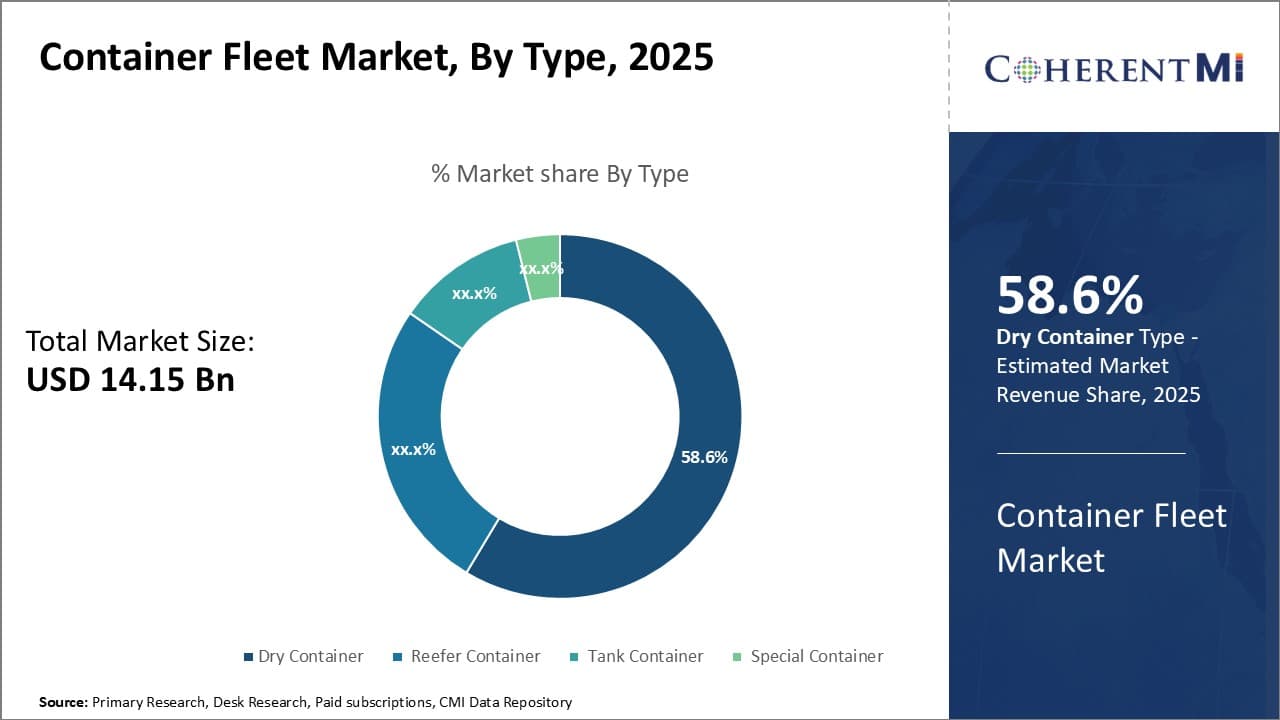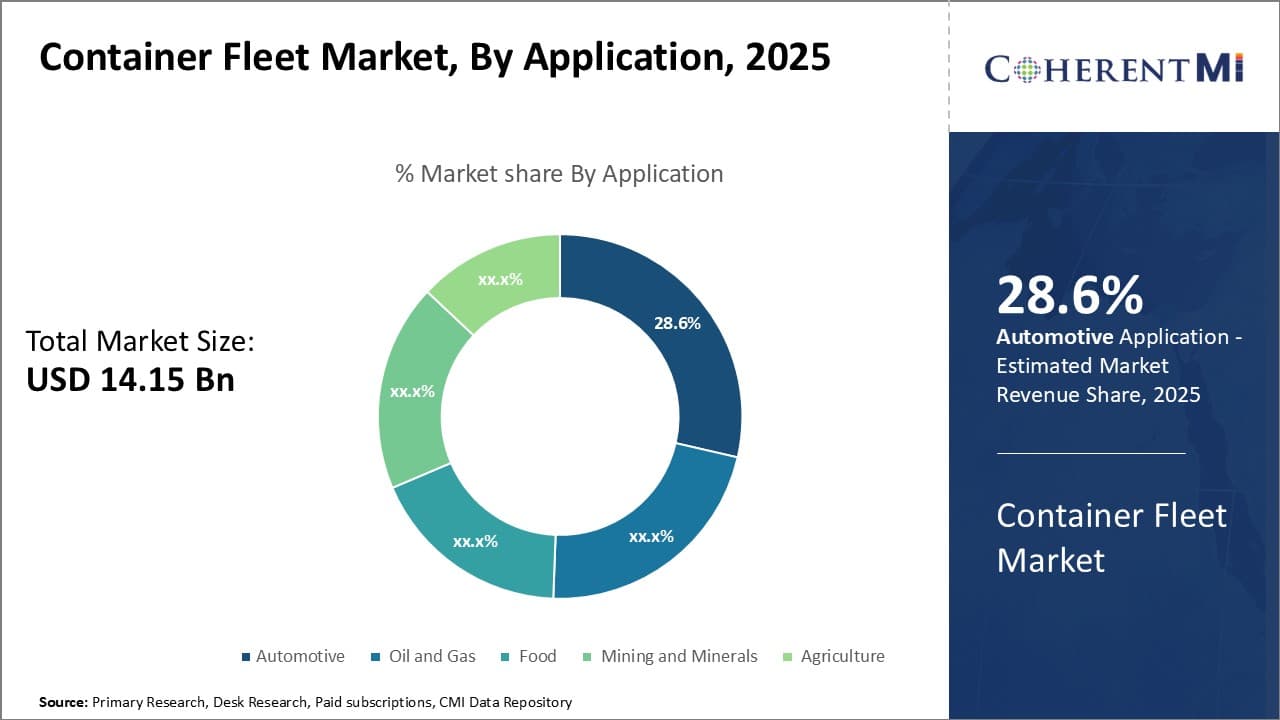

The container fleet market is estimated to be valued at USD 14.15 Billion in 2025 and is expected to reach USD 21.14 Billion by 2032, growing at a compound annual growth rate (CAGR) of 5.9% from 2025 to 2032. The demand for container shipment and transportation is increasing rapidly driven by the exponential growth in international trade. Thereby, the container fleet market has been witnessing significant growth over the past few years.
Market Size in USD Bn
CAGR5.9%
| Study Period | 2025-2032 |
| Base Year of Estimation | 2024 |
| CAGR | 5.9% |
| Market Concentration | High |
| Major Players | China COSCO Shipping Corporation Limited, CMA CGM S.A., MSC Mediterranean Shipping Company S.A., Maersk, Hapag-Lloyd AG and Among Others |
Market Driver - Rapid Growth in Global Trade and Globalization
Global trade has seen an unprecedented surge following the introduction of liberalization policies and reduction of trade barriers across countries. Containerization has emerged as the most efficient mode of transporting these goods over long distances by container fleet.
The surge in global trade volumes have considerably raised the demand for container fleet services. Manufacturing clusters have come up in different parts of the world to cater to the global supply chains of multinational corporations. Raw materials and components are shipped from resource rich regions to these manufacturing hubs for assembly and then the finished products are exported to overseas consumer markets.
Regional trade blocs like European Union and Asian powerhouses like China have also driven up intra-regional commerce. Container fleet today act as the lifeline of international trade, facilitating just-in-time deliveries. This is expected to emerge as a major driver for the container fleet market.
Market Driver - Increase in Infrastructure Development at Ports
Ports play a pivotal role in the maritime supply chain as intermediary nodal points for container handling and trans-shipment. To support the growing volumes of containerized cargo, ports across major trading nations have embarked upon massive capacity expansion and modernization programs. State-of-the-art container terminals with deep draft berths, hi-tech cargo handling equipment and expansive container yards are being developed.
Container fleet market is also witnessing development of automated terminals powered by computerized terminal operating systems. These ensure swift turnaround of container fleet. Dedicated inland clearways and rail/road linkages are also being upgraded to improve hinterland connectivity, which can immensely support growth of the container fleet market.
Several ports have also transformed into bustling logistics hubs facilitating value-added services like container repairs, stuffing/stripping, and warehousing. Manufacturers rely on these port-centric industrial clusters to optimize their supply chains. Port infrastructure development has kept pace with the larger vessels being deployed on mainline east-west trade routes. This will drive major container fleet market trends in the coming years.
 To learn more about this report, Download Free Sample Copy
To learn more about this report, Download Free Sample Copy
Market Challenge - High Capital Investment and Operational Costs
One of the major challenges being faced by the container fleet market is the high capital investment and operational costs required. Setting up container ships and ports requires large investments in building infrastructure and purchasing ships and equipment. Container ships themselves cost tens of millions of dollars each and ports require heavy machinery for loading and unloading operations.
Furthermore, with rising fuel costs and expenses related to maintenance and repairs, the operational costs of running container fleets are also very high. This puts pressure on shipping lines and fleet owners to maximize revenue from each voyage in order to realize reasonable returns on investments and cover daily operational expenses.
With tight margins in the industry, high fixed costs pose a major barrier to profits. Fleet operators have to charge competitive rates to customers to keep their businesses viable while covering their high-cost structures, which is challenging in today's container fleet market forecast.
Market Opportunity - Technological Innovations like IoT, Automation, and GPS Tracking
The container fleet market is poised to benefit significantly from ongoing technological innovations. The integration of Internet of Things (IoT) solutions, automation technologies, and advanced tracking systems can help optimize operations and reduce costs. IoT sensors installed on containers and ships can monitor temperature, humidity and other critical parameters to ensure safety and quality of cargo.
Automating loading/unloading processes through crane automation and use of robotics can improve efficiency while minimizing human errors. Advanced GPS tracking of containers and ships provides real-time location updates which helps improve asset utilization, coordination between ports/vessels, as well as offers cargo security and theft prevention.
Adoption of these new technologies allows fleet operators to supervise operations remotely, predict maintenance needs, streamline processes and enhance customer experience. This paves the way for lower operating costs and higher revenues through improved capacity utilization and customer retention for companies in the container fleet market.
Strategic Acquisitions and Consolidation: Acquiring or merging with competitors has helped players scale up and expand their fleet capacity. For example, in 2016, Maersk Line acquired Hamburg Sud, becoming the largest container shipping company. This increased its fleet size by over 50% to around 4 million TEU.
Fleet Modernization and Optimization: Leading companies have invested heavily in new, larger and more fuel-efficient ships. Additionally, optimization of routes and networks helps improve capacity utilization. For instance, Ocean Network Express (ONE) was formed in 2018 by integrating the networks of K-Line, MOL and NYK - this consolidation improved fleet utilization for the players.
Technology Adoption: Advanced technologies like IoT, telematics, analytics and automation help improve fleet performance and customer experience. For example, fleet telematics solutions from companies like MarineTraffic provide real-time location, speed and condition of vessels.
Strategic Partnerships: Collaborations help companies plug capacity gaps and network holes. For instance, THE Alliance consisting of Hapag-Lloyd, ONE, Yang Ming and HMM was formed in 2017.
 To learn more about this report, Download Free Sample Copy
To learn more about this report, Download Free Sample Copy
Insights, By Type: Dry Container Fleet Witness High Demand with Increasing Global Trade Volumes
In terms of type, dry container segment is expected to account for 58.6% share of the container fleet market in 2025. Dry containers represent the bulk of the total container fleet owing to their widespread usage across various industries. As global trade increases year-on-year, dry containers experience consistent demand for transportation of general cargo over long distances.
Dry containers allow for efficient loading and unloading of non-perishable packaged items while providing protection during overseas shipments. Along supply chains, dry containers are readily interchangeable with different vessel and road cargo configurations. This interoperability streamlines logistics and reduces transfer costs for shippers.
Growing e-commerce is another factor driving the volume of dry container shipments in the container fleet market. With worldwide consumption and emerging economies modernizing logistics infrastructure, dry container demand looks set to expand steadily. Their versatility and compatibility with diverse supply chain nodes cement dry containers' position as the most heavily deployed intermodal container fleet.
 To learn more about this report, Download Free Sample Copy
To learn more about this report, Download Free Sample Copy
Insights, By Application: Automotive Industry Witnesses Extended International Sourcing Networks
In terms of application, the automotive industry is expected to account for 28.6% revenue share of the global container fleet market in 2025. The global automotive industry relies heavily on international sourcing of components to feed complex international supply chains.
Containerized maritime shipping affords automakers reliable transport capacity and schedule flexibility to seamlessly synchronize flows of materials between factories. Similarly, exporting completed vehicles from the plant of origin to dealerships abroad occurs predominately via container shipments.
Major automakers today source standard components globally from specialized plants, basing production at strategic international hubs near important markets or resources. Containers constitute the universal intermodal unit optimizing such choreographed flows between a carmaker's far-flung facilities and supplier tiers worldwide.
Modular container loads suit this need, ensuring a continuous yet adaptable stream of inputs keeps pace with dynamic production schedules. Overall, complex international automotive supply chains have become an important part of growth prospects of the container fleet market.
The major players operating in the container fleet market include China COSCO Shipping Corporation Limited, CMA CGM S.A., MSC Mediterranean Shipping Company S.A., Maersk, Hapag-Lloyd AG Evergreen Marine Corporation, Matson Inc., Ocean Network Express Pte. Ltd., Orient Overseas Container Line Limited, Pacific International Lines Pte. Ltd., Unifeeder A/S (DP World), Wan Hai Lines Ltd., Yang Ming Marine Transport Corporation, ZIM Integrated Shipping Services Ltd., Mitsui O.S.K, Hyundai Merchant Marine Co. Ltd., and Kawasaki Kisen Kaisha Ltd.
Would you like to explore the option of buying individual sections of this report?
Gautam Mahajan is a Research Consultant with 5+ years of experience in market research and consulting. He excels in analyzing market engineering, market trends, competitive landscapes, and technological developments. He specializes in both primary and secondary research, as well as strategic consulting across diverse sectors.
Container Fleet Market is segmented By Type (Dry Container, Reefer Container, Tank Container, Specia...
Container Fleet Market
How big is the container fleet market?
The container fleet market is estimated to be valued at USD 14.15 Billion in 2025 and is expected to reach USD 21.14 Billion by 2032.
What are the key factors hampering the growth of the container fleet market?
High capital investment, high operational costs, and stringent regulations limiting expansion are the major factors hampering the growth of the container fleet market.
What are the major factors driving the container fleet market growth?
Rapid growth in global trade and globalization and increase in infrastructure development at ports are the major factors driving the container fleet market.
Which is the leading type in the container fleet market?
The leading type segment is dry container.
Which are the major players operating in the container fleet market?
China COSCO Shipping Corporation Limited, CMA CGM S.A., MSC Mediterranean Shipping Company S.A., Maersk, Hapag-Lloyd AG Evergreen Marine Corporation, Matson Inc., Ocean Network Express Pte. Ltd., Orient Overseas Container Line Limited, Pacific International Lines Pte. Ltd., Unifeeder A/S (DP World), Wan Hai Lines Ltd., Yang Ming Marine Transport Corporation, ZIM Integrated Shipping Services Ltd., Mitsui O.S.K, Hyundai Merchant Marine Co. Ltd., and Kawasaki Kisen Kaisha Ltd. are the major players.
What will be the CAGR of the container fleet market?
The CAGR of the container fleet market is projected to be 5.9% from 2025-2032.